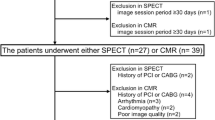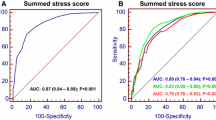Abstract
We aimed to develop color-coded CT perfusion maps (CPM) of infarcted myocardium and assess the utility of CPM in evaluating ischemic heart disease on a cardiac multi-detector CT (MDCT) in a porcine reperfused-myocardial-infarction model. Myocardial infarctions were induced by 30 min occlusions of the proximal left anterior descending coronary artery (LAD) in 17 healthy adult female pigs. First-pass and 5 min-delayed cardiac MDCTs were performed after 4 weeks of LAD occlusion. Myocardial CPMs were obtained by using the CPM program. Triphenyltetrazolium chloride (TTC)-staining was performed on the cardiac specimens. We analyzed the intermodality agreement on the size and location of the myocardial infarctions. TTC staining revealed myocardial infarction in 16 of 17 pigs, and 15 of these (94%) showed matched infarcts on the CPM and first-pass images. The areas of perfusion deficit noted in early arterial phase images and CPM coincided exactly with the areas of poor TTC staining in 12 of 15 pigs (80%). In the three remaining pigs, the areas of poor TTC staining were larger than those of a perfusion deficit demonstrated by either early arterial phase images or CPM. The agreement between these tests is calculated to be moderate to good (k = 0.736, P < 0.05). Ten myocardial segments in 4 of the 15 pigs (27%) with hypoattenuated myocardium showed a delayed enhancement on the 5 min-delayed images. Contrast-enhanced MDCT was useful and accurate in detecting chronic myocardial infarction; CPM was helpful in visualizing the infarcted myocardium.





Similar content being viewed by others
References
Gersh BJ, Anderson JL (1993) Thrombolysis and myocardial salvage. results of clinical trials and the animal paradigm—paradoxic or predictable? Circulation 8(1):296–306
Kim RJ, Fieno DS, Parrish TB et al (1999) Relationship of MRI delayed contrast enhancement to irreversible injury, infarct age, and contractile function. Circulation 100(19):1992–2002
Lee JK, Kim Y, Lee SW et al (2006) Occlusive acute myocardial infarct on 16 multidetector-row helical CT: an experimental study in rabbits. J Korean Radiol Soc 55(3):221–228 Korean
Kim RJ, Wu E, Rafael A et al (2000) The use of contrast-enhanced magnetic resonance imaging to identify reversible myocardial dysfunction. N Engl J Med 343(20):1445–1453. doi:10.1056/NEJM200011163432003
Lund GK, Stork A, Saeed M et al (2004) Acute myocaridal infarction: evaluation with first-pass enhancement and delayed enhancement MR imaging compared with 201Tl SPECT imaging. Radiology 232(1):49–57. doi:10.1148/radiol.2321031127
Kitagawa K, Sakuma H, Hirano T et al (2003) Acute myocardial infarction: myocardial viability assessment in patients early thereafter comparison of contrast-enhanced MR imaging with resting (201)Tl SPECT. Radiology 226(1):138–144. doi:10.1148/radiol.2261012108
Hilfiker PR, Weishaupt D, Marincek B (2001) Multislice spiral computed tomography of subacute myocardial infarction. Circulation 104(9):1083. doi:10.1161/hc3401.093639
Paul JF, Dambrin G, Caussin C et al (2003) Sixteen-slice computed tomography after acute myocardial infarction: from perfusion defect to the culprit lesion. Circulation 108(3):373–374. doi:10.1161/01.CIR.0000075092.94870.57
Gosalia A, Haramati LB, Sheth MP et al (2004) CT detection of acute myocardial infarction. AJR Am J Roentgenol 182(6):1563–1566
Koyama Y, Matsuoka H, Mochizuki T et al (2005) Assessment of reperfused acute myocaridal infarction with two-phase contrast-enhanced helical CT: prediction of left ventricular function and wall thickness. Radiology 235(3):804–811. doi:10.1148/radiol.2353030441
Hoffmann U, Millea R, Enzweiler C et al (2004) Acute myocardial infarction: contrast-enhanced multi-detector row CT in a porcine model. Radiology 231(3):697–701. doi:10.1148/radiol.2313030132
Kim W, Jeong MH, Hong YJ et al (2004) A new porcine model of ischemic heart failure and pathologic findings by intra-coronary injection of ethanol. Korean Circ J 34(9):900–908 Korean
Lim SY, Jeong MH, Ahn YK et al (2005) The effect of mesenchymal stem cells transduced with Akt in a porcine myocardial infarction model. Korean Circ J 35(10):734–741 Korean
Abe M, Kazatani Y, Fukuda H et al (2000) Left ventricular volumes, ejection fraction, and regional wall motion calculated with gated technetium-99 m tetrofosmin SPECT in reperfused acute myocardial infarction at super-acute phase: comparison with left ventriculography. J Nucl Cardiol 7(6):569–574. doi:10.1067/mnc.2000.108607
Watanabe K, Sekiya M, Ikeda S et al (1997) Comparison of adenosine triphosphate and dipyridamole in diagnosis by thallium-201 myocardial scintigraphy. J Nucl Med 38(4):577–581
Al-Saadi N, Nagel E, Gross M et al (2000) Noninvasive detection of myocardial ischemia from perfusion reserve based on cardiovascular magnetic resonance. Circulation 101(12):1379–1383
Rogers WJ Jr, Kramer CM, Geskin G et al (1999) Early contrast-enhanced MRI predicts late functional recovery after reperfused myocardial infarction. Circulation 99(6):744–750
Bogaert J, Maes A, de Werf FV et al (1999) Functional recovery of subepicardial myocardial tissue in transmural myocardial infarction after successful reperfusion: an important contribution to the improvement of regional and global left ventricular function. Circulation 99(1):36–43
Ito H, Tomooka T, Sakai N et al (1992) Lack of myocardial perfusion immediately after successful thrombolysis. a predictor of poor recovery of left ventricular function in anterior myocardial infarction. Circulation 85(5):1699–1705
Braunwald E, Kloner RA (1985) Myocardial reperfusion: a double-edged sword? J Clin Invest 76(5):1713–1719. doi:10.1172/JCI112160
Kloner RA, Ganote CE, Jennings RB (1974) The “no-reflow” phenomenon after temporary coronary occlusion in the dog. J Clin Invest 54(6):1496–1508. doi:10.1172/JCI107898
Naito H, Saito H, Ohta M et al (1990) Significance of ultrafast computed tomography in cardiac imaging: usefulness in assessment of myocardial characteristics and cardiac function. Jpn Circ J 54(3):322–327
Lee KS, Marwick TH, Cook SA et al (1994) Prognosis of patients with left ventricular dysfunction, with and without viable myocardium after myocardial infarction. relative efficacy of medical therapy and revacularization. Circulation 90(6):2687–2694
De Roos A, van Rossum AC, van der Wall E et al (1989) Reperfused and nonreperfused myocardial infarction: diagnostic potential of Gd-DTPA-enhanced MR imaging. Radiology 172(3):717–720
Lima JA, Judd RM, Bazille A et al (1995) Regional heterogeneity of human myocardial infarcts demonstrated by contrast-enhanced MRI. potential mechanisims. Circulation 92(5):1117–1125
Gerber BL, Garot J, Bluemke DA et al (2002) Accuracy of contrast-enhanced magnetic resonance imaging in predicting improvement of regional myocardial function in patients after acute myocardial infarction. Circulation 106(9):1083–1089. doi:10.1161/01.CIR.0000027818.15792.1E
Beek AM, Kuhl HP, Bondarenko O et al (2003) Delayed contrast-enhanced magnetic resonance imaging for the prediction of regional functional improvement after acute myocardial infarction. J Am Coll Cardiol 42(5):895–901. doi:10.1016/S0735-1097(03)00835-0
Choe YH, Choo KS, Jeon E-S et al (2008) Comparison of MDCT and MRI in the detection and sizing of acute and chronic myocardial infarcts. Eur J Radiol 66:292–299. doi:10.1016/j.ejrad.2007.06.010
Author information
Authors and Affiliations
Corresponding author
Rights and permissions
About this article
Cite this article
Yim, N.Y., Kim, YH., Choi, S. et al. Multidetector-row computed tomographic evaluation of myocardial perfusion in reperfused chronic myocardial infarction: value of color-coded perfusion map in a porcine model. Int J Cardiovasc Imaging 25 (Suppl 1), 65–74 (2009). https://doi.org/10.1007/s10554-008-9411-4
Received:
Accepted:
Published:
Issue Date:
DOI: https://doi.org/10.1007/s10554-008-9411-4




